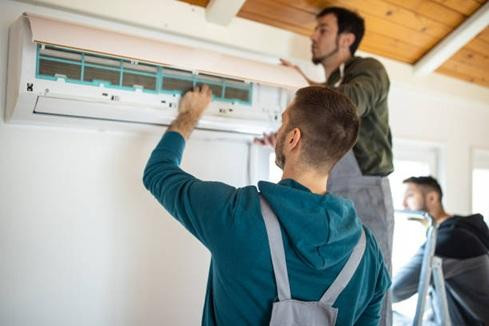Aging System and Declining Performance
One of the primary indicators that it is time to replace a ductless HVAC system is its age. Most ductless mini-split systems have a lifespan of 10 to 15 years, depending on usage and maintenance. As the system ages, its efficiency declines, leading to inconsistent temperatures, longer run times, and increased energy consumption. Older units may struggle to maintain the desired indoor climate, resulting in uneven cooling or heating across different zones. If a system is nearing the end of its expected lifespan and requires frequent repairs, replacing it with a newer, more efficient model can provide better performance and long-term savings on energy costs.
Frequent Repairs and Rising Maintenance Costs
While routine maintenance is essential for keeping a ductless system in optimal condition, frequent repairs can be a sign that the unit is reaching the end of its useful life. If homeowners find themselves repeatedly calling for service due to issues such as refrigerant leaks, sensor malfunctions, or compressor failures, the cost of repairs can quickly add up. When repair expenses begin to approach or exceed the cost of a new system, it becomes more economical to invest in a replacement. Newer models offer improved reliability, advanced technology, and enhanced energy efficiency, reducing the likelihood of costly breakdowns and maintenance issues.
Reduced Energy Efficiency and High Utility Bills
An increase in energy bills without a corresponding change in usage is a strong indication that a ductless system is losing efficiency. Over time, wear and tear on components such as the compressor, evaporator coils, and fans can reduce the unit’s ability to cool or heat efficiently. A struggling system must work harder to maintain the desired temperature, consuming more electricity in the process. Upgrading to a modern ductless system with higher Seasonal Energy Efficiency Ratio (SEER) and Heating Seasonal Performance Factor (HSPF) ratings can significantly lower energy consumption. Advanced features such as inverter technology and smart thermostats further improve efficiency, providing better climate control while reducing operational costs.
Poor Air Quality and Inconsistent Comfort
A properly functioning ductless system plays a crucial role in maintaining indoor air quality by filtering out dust, allergens, and pollutants. If homeowners notice an increase in dust accumulation, musty odors, or allergy symptoms, it may indicate that the system is no longer effectively filtering the air. Additionally, inconsistent temperature regulation—where some rooms feel too hot while others remain too cold—can be a sign that the unit’s performance is declining. If cleaning and servicing the system do not resolve these issues, replacing it with a new model equipped with advanced filtration and improved airflow control can enhance indoor air quality and overall comfort.
Outdated Technology and Lack of Modern Features
Technology in HVAC maintenance contract has advanced significantly in recent years, offering improved efficiency, better performance, and greater user convenience. Older ductless systems may lack modern features such as programmable thermostats, Wi-Fi connectivity, and zoning capabilities that allow homeowners to customize temperature settings for different areas. Smart HVAC systems enable remote access and integration with home automation systems, providing more control over energy usage and comfort settings. If an existing ductless unit lacks these advanced features, upgrading to a new system can provide enhanced functionality, better energy management, and a more user-friendly experience.
Changes in Home Comfort Needs
Homeowners' comfort needs may change over time due to renovations, additions, or lifestyle adjustments. If a household has expanded living spaces or converted areas such as garages, basements, or attics into functional rooms, the existing ductless system may no longer be sufficient to handle the increased cooling and heating demands. Additionally, if a system was initially installed with minimal zones and the occupants now require more precise climate control in different areas, upgrading to a multi-zone ductless system can provide better temperature regulation. Evaluating whether the current system meets the home’s evolving needs is an essential factor in deciding whether to replace it.
Refrigerant Phase-Out and Environmental Concerns
Many older ductless systems use refrigerants such as R-22, which have been phased out due to their harmful impact on the environment. If a system relies on outdated refrigerants, recharging it can become increasingly expensive and difficult as supplies dwindle. New ductless models use environmentally friendly refrigerants such as R-410A, which offer improved efficiency and lower greenhouse gas emissions. Replacing an outdated unit with a system that uses modern refrigerants ensures compliance with environmental regulations while reducing the home’s carbon footprint and energy consumption.
Conclusion
Deciding when to replace a ductless HVAC system depends on various factors, including its age, performance, energy efficiency, and maintenance costs. Frequent repairs, rising utility bills, inconsistent temperatures, and poor air quality are strong indicators that a replacement may be necessary. Additionally, advancements in HVAC technology and changes in home comfort needs may warrant an upgrade to a more efficient and feature-rich system. By investing in a new ductless system, homeowners can enjoy improved indoor comfort, lower energy costs, and better air quality while reducing their environmental impact. Recognizing these signs early and consulting with HVAC professionals can help ensure a smooth transition to a modern, high-performing system.
Contact Us
"Samsung AC Service Center - Instacool
Barsha Business Square - Al Barsha - Al Barsha 1 - Dubai - United Arab Emirates
Instacool - Samsung AC Service Center
Z9 Plot C1 - Mohamed Bin Zayed City - Abu Dhabi - United Arab Emirates"
"Land Line: 043797947
Mobile: 0505059055"
info@instacool.ae

